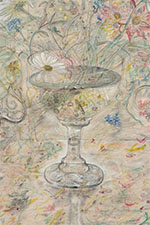Kettle's Yard
a living place where works of art could be enjoyed, inherent to the domestic setting, where young people could be at home unhampered by the greater austerity of the museum or public art gallery" Jim Ede, 1970
Kettle’s Yard is a beautiful house with a remarkable collection of modern art and a gallery that hosts modern and contemporary art exhibitions. Between 1957 and 1973 Kettle’s Yard was the home of Jim and Helen Ede. In the 1920s and 30s Jim had been a curator at the Tate Gallery in London. Thanks to his friendships with artists and other like-minded people, over the years he gathered a remarkable collection, including paintings by Ben and Winifred Nicholson, Alfred Wallis, Christopher Wood, David Jones and Joan Miró, as well as sculptures by Henri Gaudier-Brzeska, Constantin Brancusi, Henry Moore and Barbara Hepworth.
Kettle’s Yard was originally conceived with students in mind. Jim kept ‘open house’ every afternoon of term, personally guiding visitors around his home. In 1966 he gave the House and its contents to the University of Cambridge. In 1970, three years before the Edes retired to Edinburgh, the House was extended, and an exhibition gallery added. The House is by and large as they left it. There are artworks in every corner, and there are no labels.
The first items in this new collection relate to the poet and painter David Jones. A Cambridge Humanities Research Grant let Kettle’s Yard and the David Jones Research Center start work in 2021 on a digital edition of documents by and about Jones in Kettle’s Yard’s collection. These include the 122 extant letters from Jones (1895-1974) to his friend and patron the curator and collector Harold Stanley (“Jim”) Ede (1895-1990), the house-museum Kettle’s Yard’s founder. Kettle’s Yard holds Ede’s artworks by Jones, among them notable watercolours and “painted inscriptions”; here, high-resolution scans of ten of these accompany the correspondence, which frequently recurs to them. Other items of interest abound.
The letters run from October 1927 to December 1971, from shortly after they met in 1924—in London, where Ede worked at the Tate and often hosted Jones at his Hampstead home—to shortly before Jones’s death in 1974. Jones and Ede shared (separate) backgrounds in the army and art school; they bonded especially over mutual bemusement at the fate of art in a secular age. Their correspondence covers everything from Hitler ( KY/EDE/1/8/1/25 ) to Horizon , in whose August 1943 issue Ede published a profile of Jones that draws closely on an extensive autobiographical apologia, preserved here, that Jones bid Ede attend to ( KY/EDE/1/8/1/19 ).
The editors thank the Trustees of the David Jones Estate for permission to present this material.


